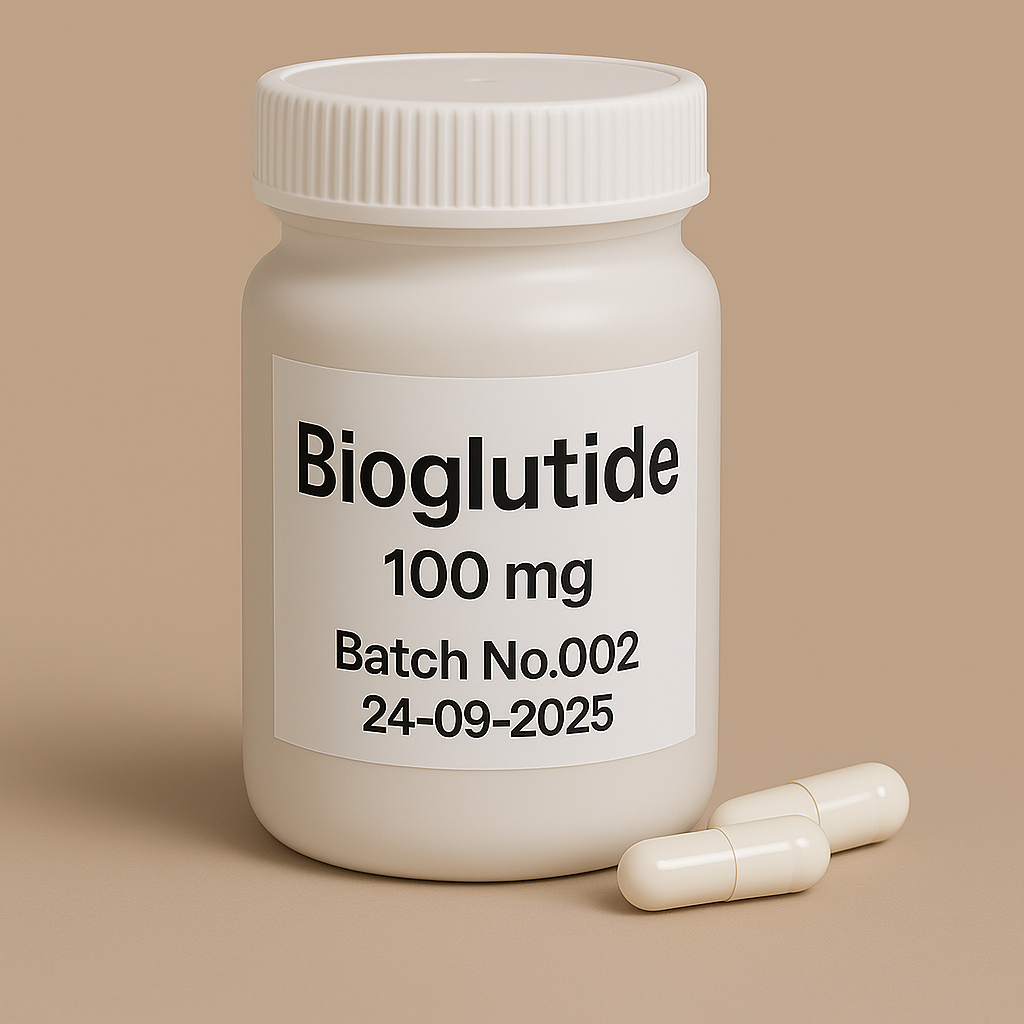
Bioglutide 100x100mg
Recolha atualmente indisponível
NOT FOR HUMAN CONSUMPTION
Bioglutide (NA-931) is positioned as a once-daily pill aiming to combine incretin satiety/glycaemic control (GLP-1, GIP), energy-expenditure and hepatic lipid effects (glucagon), and anabolism/lean-mass support (claimed IGF-1 receptor activity). If verified, the mix would theoretically pair deep appetite suppression with higher energy expenditure and better body-composition quality than GLP-1 monotherapy. Evidence confirming direct IGF-1 receptor agonism by a small molecule is sparse in the literature, so this aspect should be viewed as unproven pending peer-review.
Additional Benefits of Bioglutide Now Under Investigation
| Benefit | Key take-aways |
|---|---|
| 1 Oral, multi-pathway weight loss | Company-reported Phase 2 data (13 weeks) cite double-digit mean weight loss at higher doses, with placebo-adjusted reductions >10% in top arms. Independent, peer-reviewed confirmation is pending. |
| 2 Glycaemic control in T2D | Aims to deliver A1c reductions comparable to injectable incretins while being oral; formal peer-reviewed T2D results have not yet been published. |
| 3 Energy-expenditure boost (GCGR) | Glucagon receptor engagement is expected to raise resting energy expenditure and promote fat oxidation, potentially countering metabolic adaptation seen with weight loss. Human EE data for NA-931 have not been publicly vetted. |
| 4 Lean-mass preservation (IGF-axis) | By adding an IGF-1 component, NA-931 is pitched to preserve muscle during weight loss; direct evidence in humans has not been disclosed in peer-review. |
| 5 Liver fat & MASH signals | A quadruple profile could reduce MRI-PDFF and improve ALT/AST (weight loss + glucagon hepatolipid effects); trials in metabolic liver disease are referenced as ongoing/planned. |
| 6 Convenience & adherence | Oral dosing may improve uptake and persistence vs injectables for some patients, assuming tolerability is favorable. |
| 7 Combination potential | Company materials suggest add-on use with GLP-1/GIP injectables (e.g., semaglutide/tirzepatide) for extra weight loss; this is hypothesis-generating only. |
| 8 Cardiometabolic risk factors | Expectation (by mechanism/class): BP and triglyceride reductions, non-HDL/apoB improvements; formal datasets for NA-931 are not yet public. |
| 9 Patient-reported outcomes | Anticipated gains in satiety, cravings, physical function—data not yet peer-reviewed for NA-931. |
2. Molecular Mechanism of Action
2.1 Receptor pharmacodynamics (claimed)
-
GLP-1R: ↓ appetite, ↓ gastric emptying; glucose-dependent insulin↑, glucagon↓ post-meal.
-
GIPR: Potentiates insulin secretion; may improve adipocyte metabolic flexibility and GI tolerability with GLP-1.
-
GCGR (glucagon): ↑ energy expenditure and fat oxidation; mobilizes hepatic lipid with careful glycaemic counter-balance.
-
IGF-1R (claimed): Anabolic/anti-catabolic signaling (Akt–mTOR); preservation of lean mass. Note: Direct, selective small-molecule IGF-1R agonism is biologically unusual and currently unverified for NA-931 outside company statements.
2.2 Down-stream biology
| Pathway | Functional outcome | Context |
|---|---|---|
| POMC/AgRP (CNS) | Satiety ↑, cravings ↓ | Appetite circuits |
| Islet incretin signaling | Glucose-dependent insulin ↑ | Pancreas |
| Hepatic lipid handling (GCGR) | Fat oxidation ↑, steatosis ↓ | Liver |
| Akt–mTOR (IGF-axis) | Protein synthesis/lean mass support | Muscle (theoretical for NA-931) |
3. Pharmacokinetics
-
Formulation/Route: Oral tablet, once daily (company reports).
-
Half-life/Exposure: Not published in peer-review; dose-ranging has been presented in company communications.
-
Food effect/Absorption: Not disclosed in detail.
-
Drug–drug: No public interaction matrix yet.
4. Pre-clinical & Clinical Evidence (what’s public)
-
Phase 2 obesity (company-reported): ~13-week study with dose-dependent weight loss; a high-dose arm reportedly ~14–15% total body-weight reduction and ~13% placebo-adjusted—awaiting peer-review and full protocol transparency.
-
Development status: Communicated as moving toward Phase 2b/3 in obesity/T2D; registry and pipeline round-ups list NA-931 in mid-stage development.
Evidence quality note: To date, nearly all information comes from company press releases, industry trade coverage, or pipeline summaries—not peer-reviewed journals. Treat efficacy magnitudes and receptor claims as preliminary.
5. Emerging Clinical Interests
| Field | Rationale | Status |
|---|---|---|
| Chronic weight management | Oral option with multi-hormone pharmacology | Phase 2→2b/3 (company) |
| Type 2 diabetes | A1c + weight + potential metabolic flexibility | Planned/ongoing per company |
| MASH/NAFLD | Weight + glucagon-driven hepatic lipid effects | Exploratory |
| Combination with injectables | Additive weight loss hypothesis | Preclinical/company claims |
6. Safety and Tolerability (what to expect, what we don’t know)
-
Likely class AEs (if incretin-dominant): Nausea, vomiting, diarrhea/constipation, abdominal pain (generally titration-dependent).
-
Glucagon component: Possible ↑ heart rate, glycaemic counter-pressure (balanced by GLP-1/GIP); monitor BP/HR.
-
IGF-axis concerns (theoretical): If genuine IGF-1R agonism occurs, watch edema, hypoglycaemia (low risk), and mitogenic signaling—though this is unconfirmed for NA-931.
-
Unknowns: Long-term safety, gallbladder events with large weight loss, pancreato-biliary risks, drug–drug interactions.
-
Contraindications/caution (by class analogy): History of MEN2/MTC (GLP-1 class warning), gastroparesis, pregnancy. Final labeling, if any, will determine specifics.
Comparative snapshot (tentative)
| Feature | Bioglutide (NA-931) | Tirzepatide | Semaglutide |
|---|---|---|---|
| Modality | Oral small molecule | Injectable peptide | Oral & injectable peptide |
| Targets | GLP-1/GIP/GCGR + IGF-1 (claimed) | GLP-1 + GIP | GLP-1 |
| Weight-loss magnitude | Company-reported double-digit at 13 wks | 15–22% at 72 wks (RCTs) | 12–17% at 68–104 wks (RCTs) |
| Peer-reviewed evidence | Not yet | Robust | Robust |
7. Regulatory Landscape
-
Not approved by FDA/EMA; investigational.
-
Public materials describe Phase 2→2b/3 programs in obesity and T2D, with additional studies proposed (e.g., MASH).
8. Practical Take
-
Promising concept, but extraordinary claims (quadruple agonism incl. IGF-1R) demand extraordinary evidence.
-
Until peer-reviewed trial reports with detailed methods, safety tables, pharmacokinetics, and receptor pharmacology are available, treat Bioglutide’s efficacy and mechanism as provisional.
-
For patients today, approved incretin therapies (semaglutide, tirzepatide, etc.) remain the evidence-basedchoices; Bioglutide is a watch-this-space candidate.
Selected References
-
Company materials: Biomed Industries—NA-931 (Bioglutide) product page, press releases, and Phase-2 summaries (quadruple agonist, oral, obesity/T2D).
-
Industry coverage: FirstWord Pharma news on NA-931 program updates and claimed trial readouts.
-
Pipeline round-ups: Prime Therapeutics GLP-1 pipeline brief; Larvol Delta product tracker; Patsnap/Synapse drug entry summarizing company-reported Phase 2 figures.
-
Context reviews: Triple-agonist reviews outlining rationale for GLP-1/GIP/GCGR combinations (without IGF-1R).

